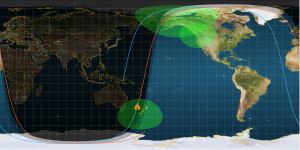It’s hard to believe it’s been two weeks since we launched our first satellite, BlackSky’s Pathfinder-1. We’ve been working 24/7 through early operations with our demonstration spacecraft and wanted to share a brief recap of our first weeks of spacecraft operations.
In a nutshell, Pathfinder-1 is exceeding our expectations. As engineers, that’s a significant statement for us to make, but one we’re very proud of.
Here’s what that checklist looks like to us:
Successful Launch – CHECK
On September 25, we all watched breathlessly as the Indian PSLV rocket lifted off and quickly disappeared into the clouds over Sriharikota, India. Nearly 2.5 hours later, Pathfinder-1 was the last of 8 spacecraft to be released to orbit (over the Pacific Ocean — about 1000 km off the coast of Chili, flying northwest, paralleling the Pacific coastline). A few minutes later we received a call from Sriharikota providing us with the drop off telemetry data and our operations team raced to intercept the first pass! We acquired signal from the satellite on its first pass up the Pacific coast about 30 minutes after launch, and began downloading satellite telemetry in the hours after launch. We spent most of the next day improving our positional knowledge of the spacecraft to improve the reliability of communications & telemetry downloads.
Complete satellite bus checkout phase – CHECK
With a first generation satellite system, you always expect to learn things during early operations. We have indeed been learning lots as we operate both the satellite and ground architecture, and have been pleased with the robustness of the system! In fact, in less than 10 days, all of our subsystem checkout activities, have been completed ahead of schedule. Some of the key checkout activities include assessing power system performance, quantifying the pointing accuracy, calibrating our control system, and establishing reliable space-to-ground communications over our high and low rate data links.
Ground Stations support all mission operations – CHECK

With the spacecraft operating exceptionally well with reliable low gain communications via our UHF comms link, we started bringing up the high rate communications system, which is comprised of S-band uplink and X-band downlink. Our first priority was downloading all of the detailed telemetry files to validate spacecraft performance. Everything worked to plan. Pathfinder-1 utilizes our Spaceflight Networks ground architecture, and now that spacecraft checkout is complete, we are transitioning to automated operations.
Full loop architecture performance – CHECK
For the Pathfinder mission, Spaceflight developed the entire BlackSky space and ground architecture. Both have worked exceptionally well since launch day. We received signals from our satellites on the first opportunity and we have had uninterrupted communication with the satellite since then. We’ve completed the initial checkout phases and are now in the process of working through payload calibration as well transitioning to automated operations.
At launch +2 weeks, we have an operations architecture in space AND on the ground that we trust enough to begin automated operations which is testament to our team and their preparation leading to launch.
Letting that soak in.
The team is beginning payload checkout and calibration operations. We have a thorough plan to commission and evaluate our imaging system over the upcoming weeks and are excited to be entering this mission stage.
And sleep. That’s definitely next, but it’s too darn exciting!

